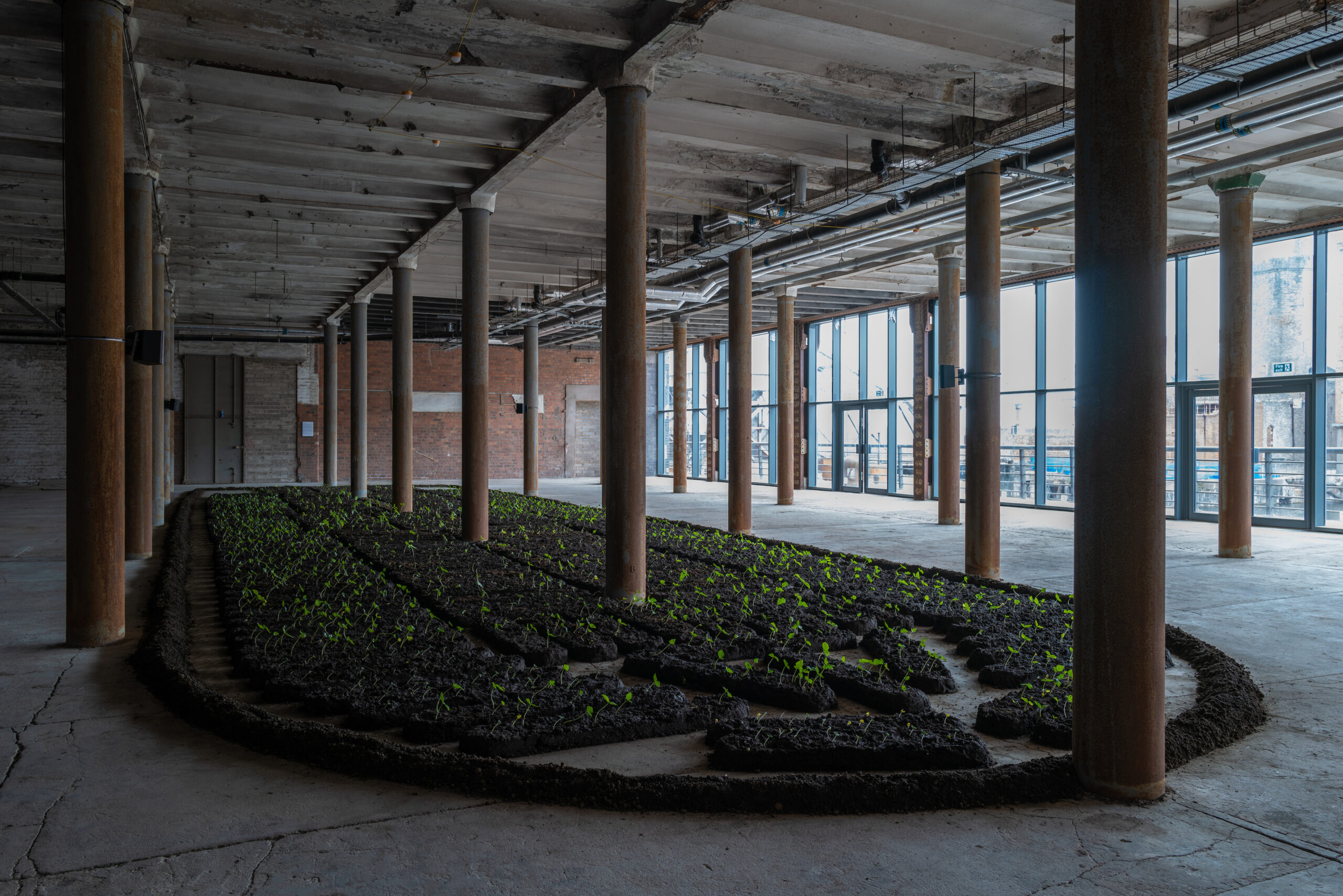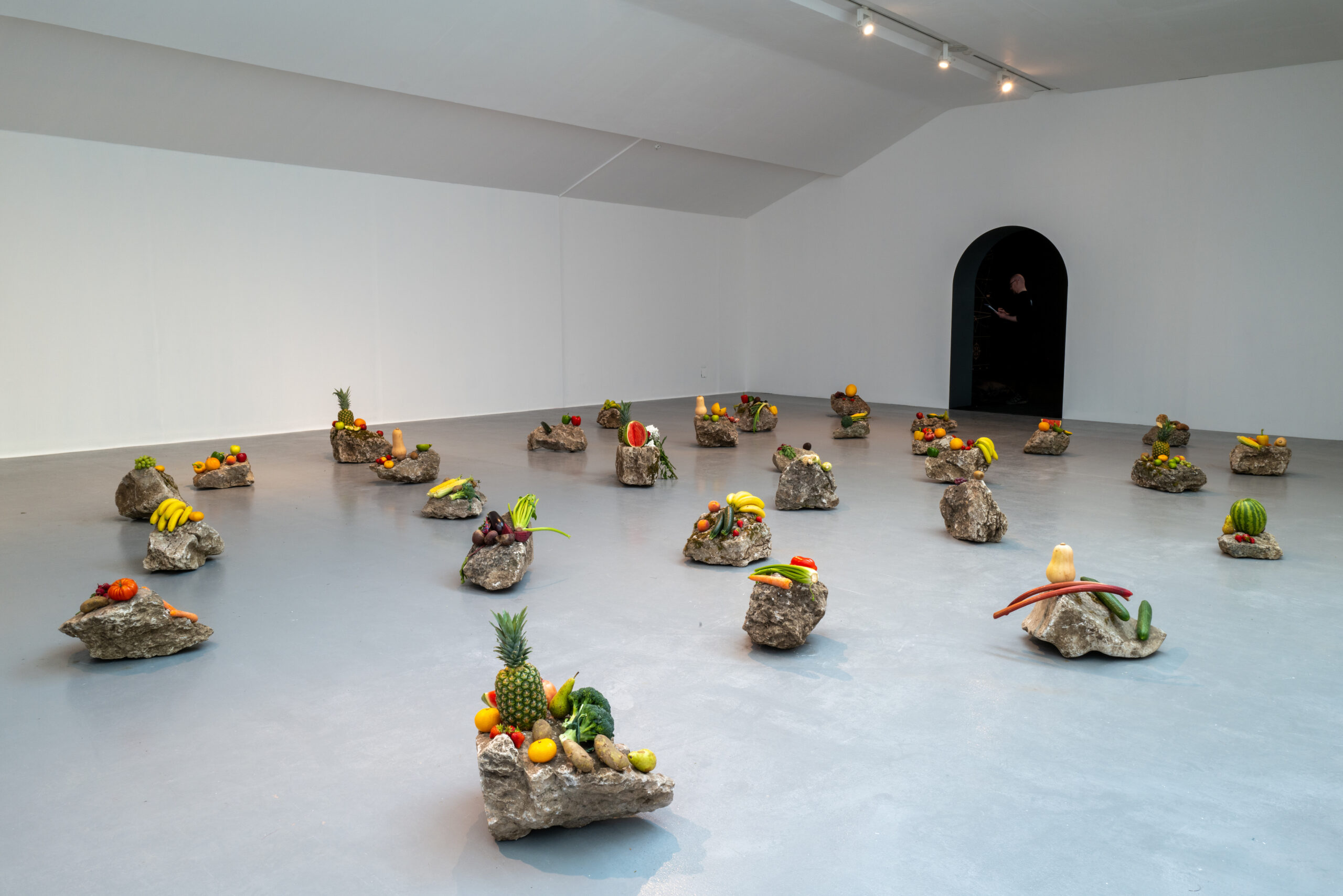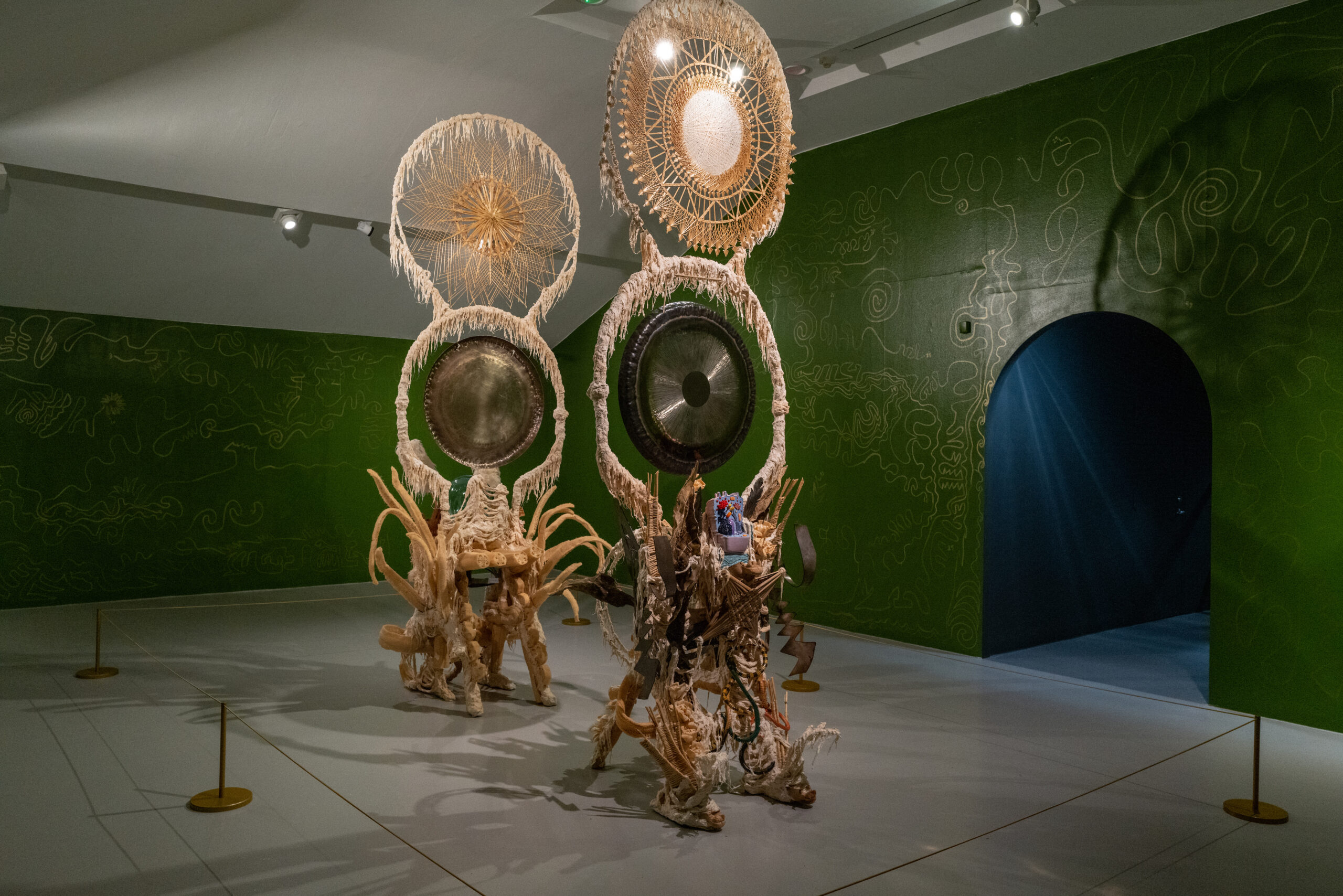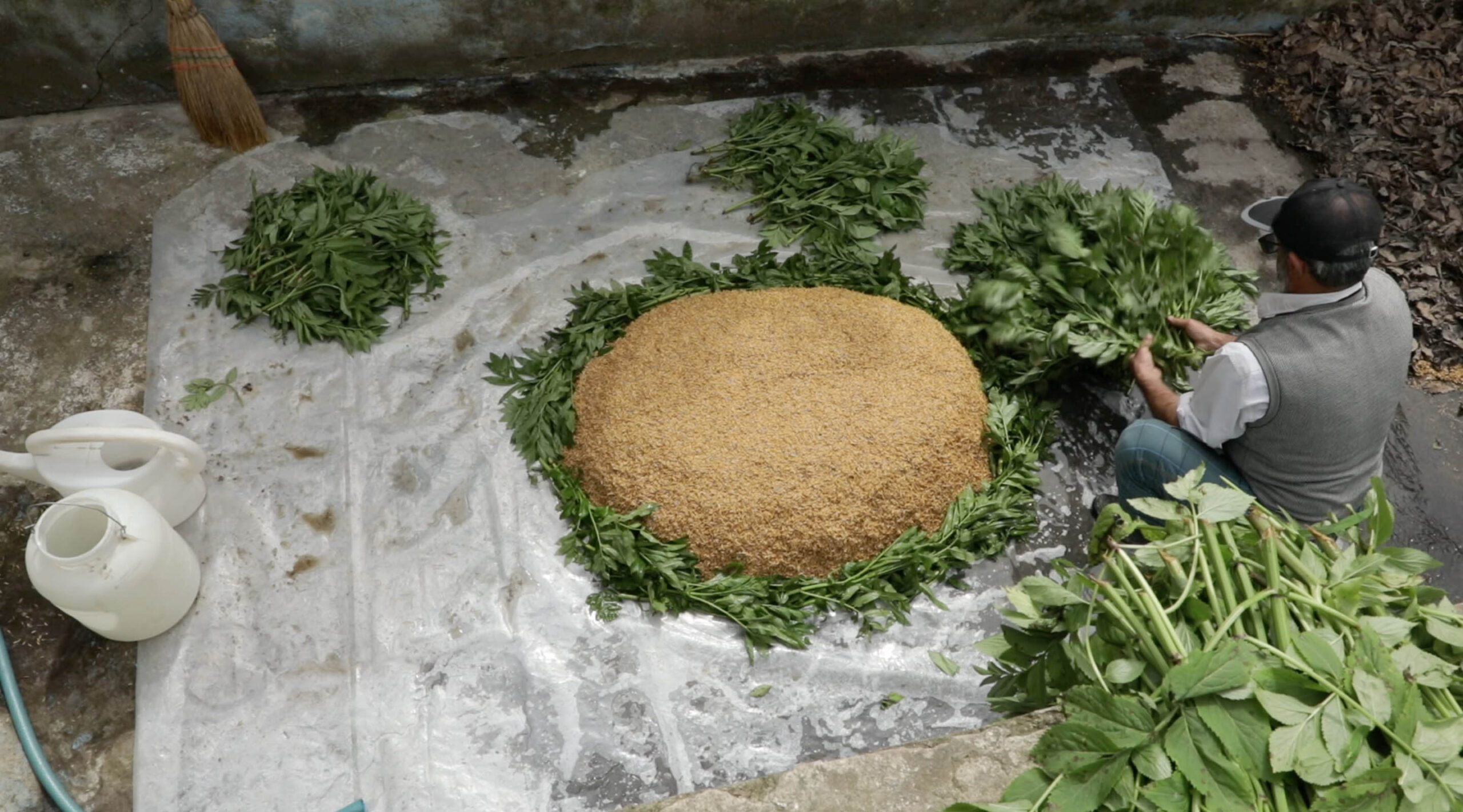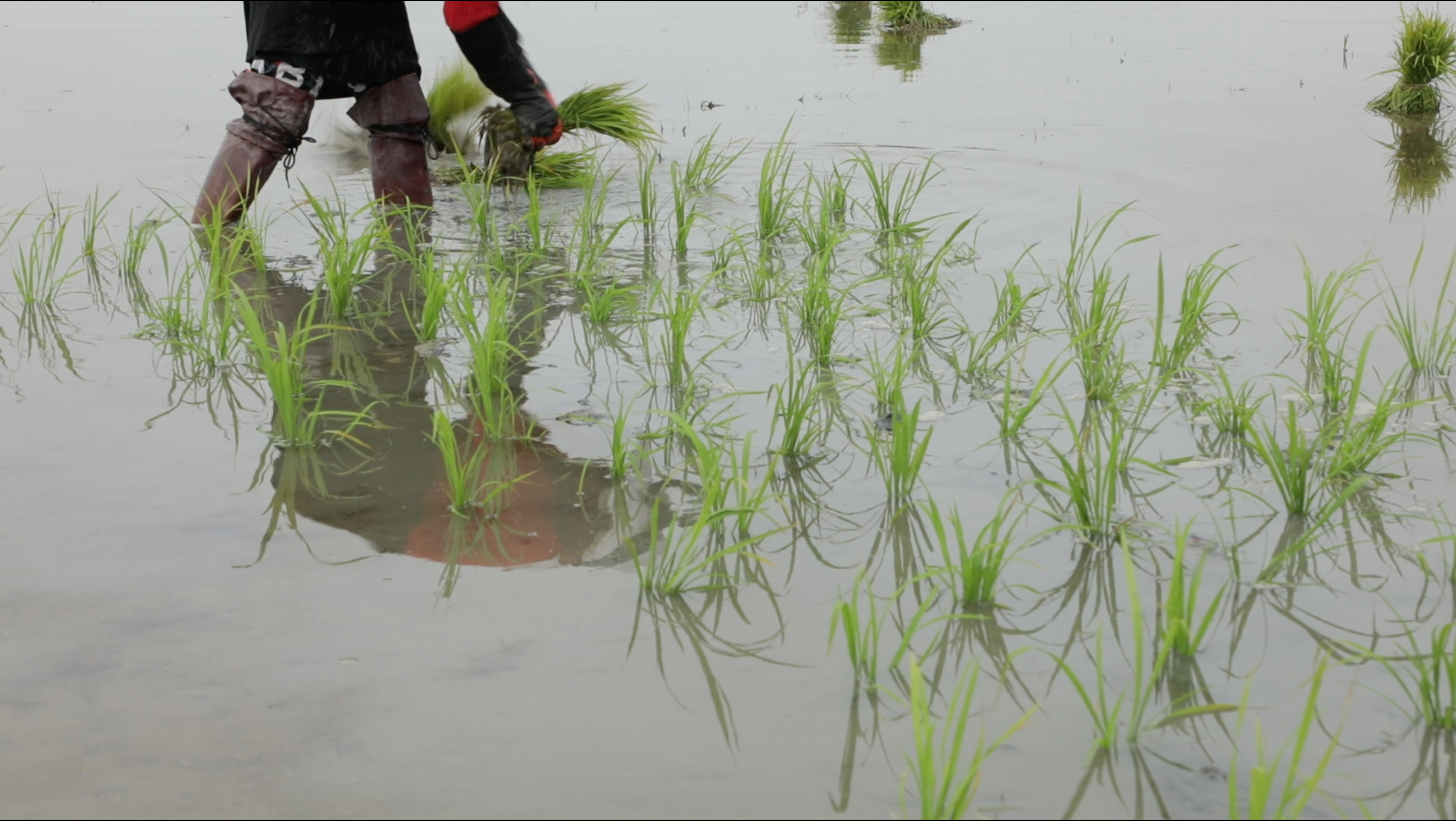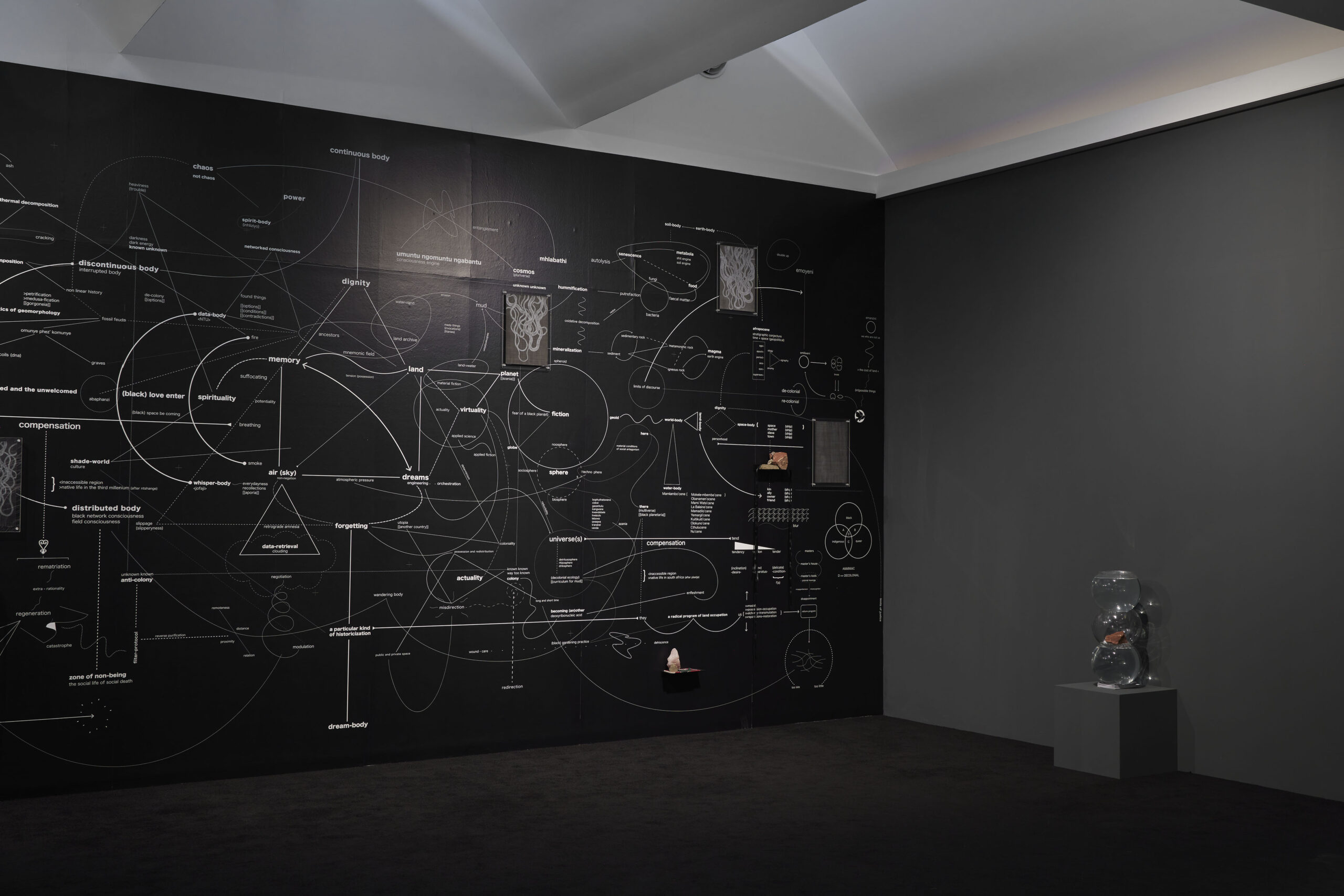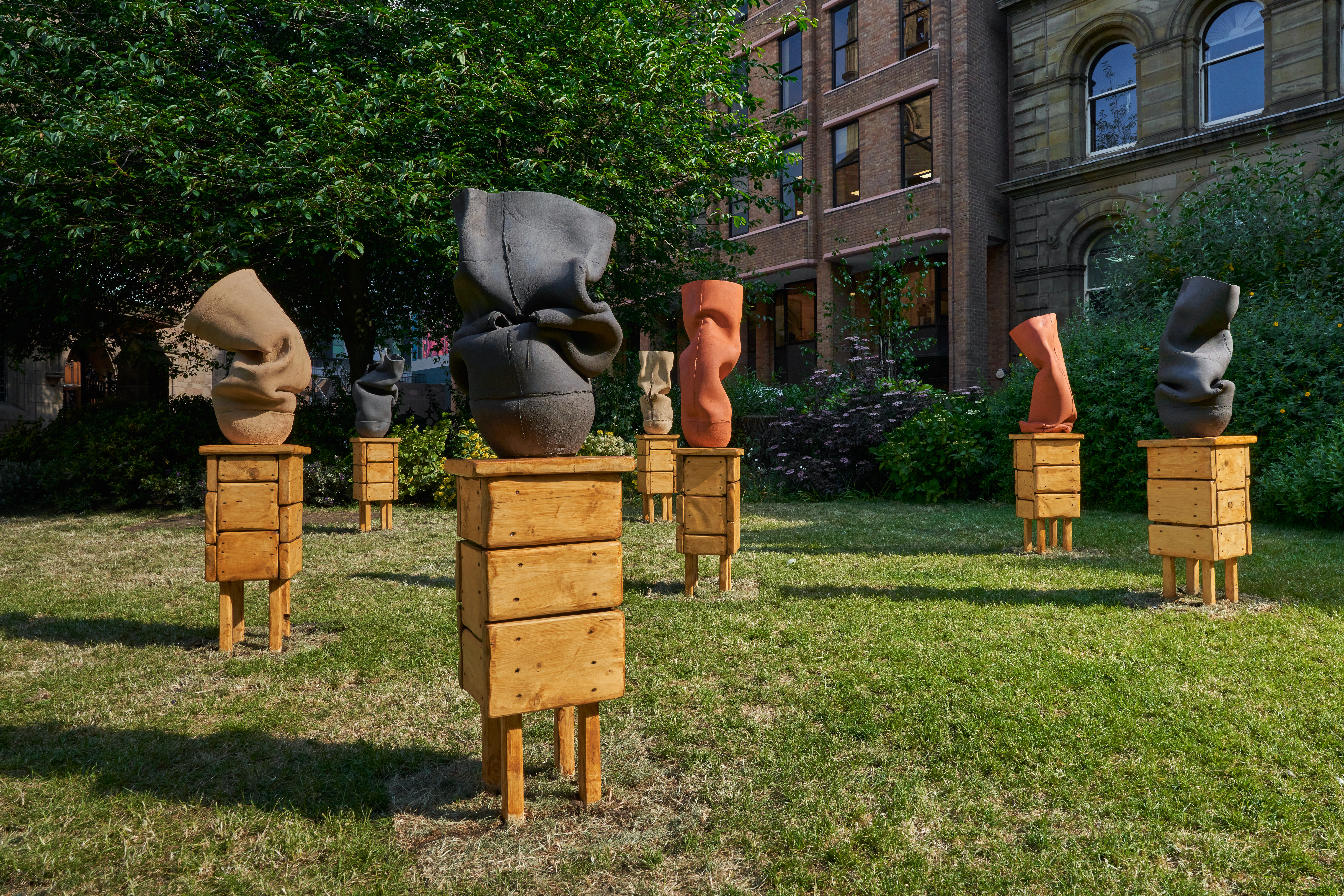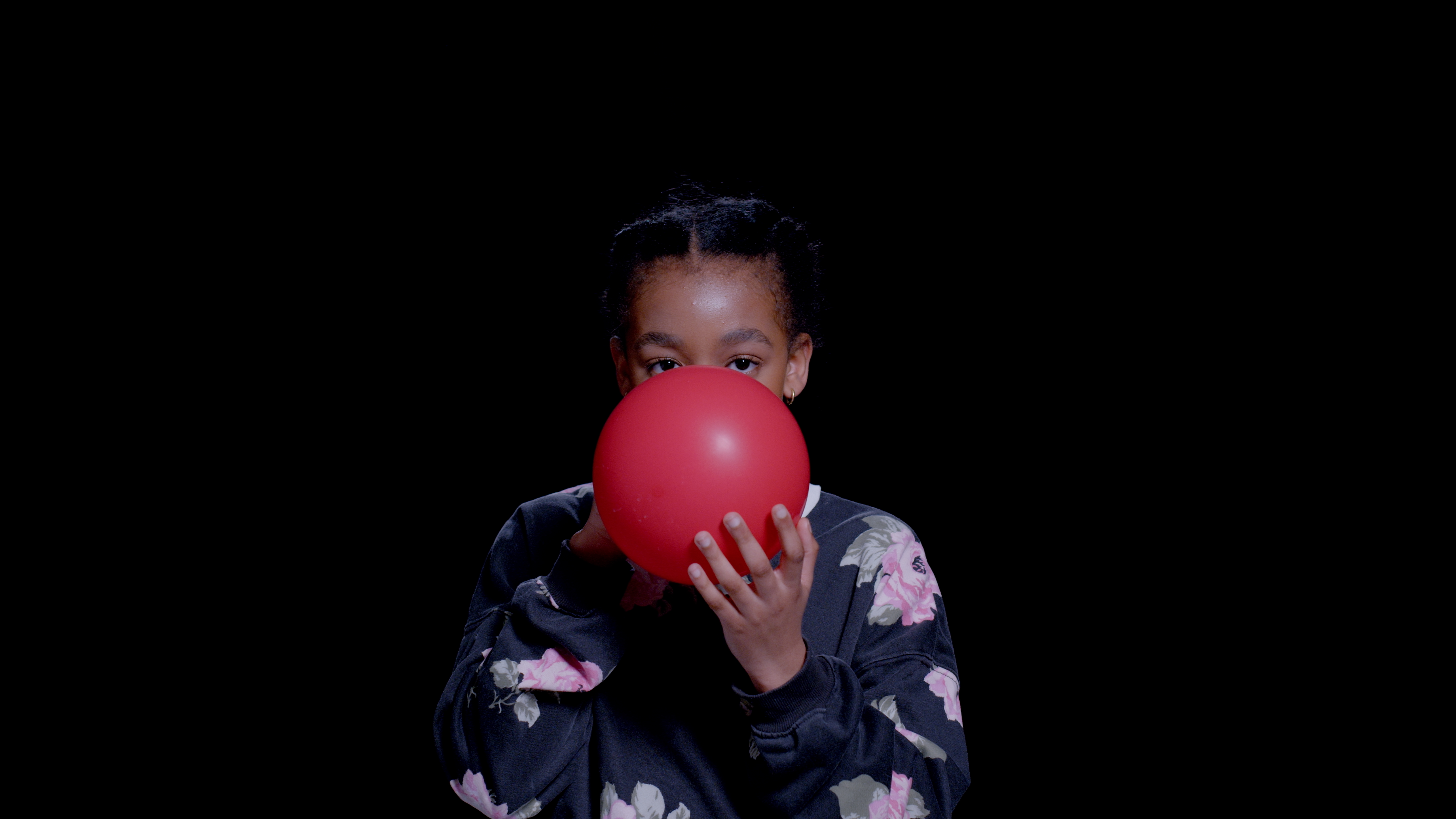The 12th Liverpool Biennial: Actual and Curatorial Displacements
Nolan Oswald Dennis, No conciliation is possible (working diagram), installation detail, 2023, wallpaper, archival notes, hand-drawn notes, found objects, and pencil drawings [photo: Stuart Whipps; courtesy of the artist and Liverpool Biennial, Liverpool]
Share:
Drawing on the isiZulu word for spirit, breath, air, climate, and wind, the 12th Liverpool Biennial, uMoya: The Sacred Return of Lost Things, was curated by Khanyisile Mbongwa to address “the history and temperament of the city of Liverpool” and to “call for ancestral and indigenous forms of knowledge, wisdom and healing.” These thematic pillars, expressed in works by more than 30 artists and collectives, stem from Liverpool’s legacy as Britain’s main trading port for the sale of people during slavery. That context was highlighted by two locations in particular: the Cotton Exchange, where trade in cotton was once conducted, and the Tobacco Warehouse, the world’s largest brick warehouse constructed between 1898 and 1901.
At the Tobacco Warehouse, a monument to Britain’s colonial economy, Binta Diaw’s Chorus of Soil (2023) presented a near 1:1 scale plan of the Liverpool-based slave ship Brooks—made from soil and sprouting seeds laid on the floor—based on an 18th-century visualization of the conditions in which more than 5,000 enslaved people were transported to plantations in the Caribbean from West Africa. Heard around the installation were recordings of Liverpool inhabitants reciting M. NourbeSe Philip’s Zong! (2008). That epic poem draws upon the legal case between the shipowners and insurers of a slave ship, from which 130 enslaved Africans were thrown overboard in 1781, after navigational errors reduced water rations onboard.
Binta Diaw, Chorus of Soil, 2023, seeds and soil [photo: Mark McNulty; courtesy of the artist and Liverpool Biennial, Liverpool]
Surrounding this central installation were two works. Isa do Rosário’s Dança com a Morte no Atlântico (Dance with Death on the Atlantic Sea (2013–2023). Comprising black dots and figures expressively painted on a long, horizontal textile work made of white panels on blue fabric, it pays tribute to those who lost their lives to the Transatlantic Slave Trade. Albert Ibokwe Khoza’s The Black Circus of the Republic of Bantu (2022), a powerful adaptation of a performance of the same name, included two videos wherein Khoza appears dressed in Afrofuturist costumes that are also presented as sculptures within the warehouse, including white paper headdresses in the shapes of a ship and an airplane. The video footage overlaps with archival images, illustrating the connection Khoza makes between ethnographic human exhibitions in 19th-century Euro-American World’s Fairs and the presentation of artists of color in international art exhibitions today.
At one point, Khoza describes their decision as an international artist to work only with Black curators to avoid an enduringly reductive colonialist gaze that limits the horizons of Black expression. After all, as Mbongwa has stated, Africa’s history does not begin and end with colonialism and slavery. There’s ancestral and indigenous wisdom, as well as deep knowledge and abundant joy to honor there, too. uMoya illuminates these layers, with Khoza embodying the exhibition’s intention to explore “the ways in which people and objects have the potential to manifest power as they move across the world, while acknowledging the continued losses of the past.”
Edgar Calel, Ru k’ox k’ob’el jun ojer etemab’el (The Echo of an Ancient Form of Knowledge), 2021, stones, fruits, and vegetables [photo: Mark McNulty; courtesy of the artist and Liverpool Biennial, Liverpool]
At Tate Liverpool, that movement of people and objects through time and space was routed to create healing connections between the Black Atlantic and Indigenous communities in the Americas, who likewise suffered from colonial enslavement and displacement. The fruits and vegetables placed on stones in Edgar Calel’s Ru k’ox k’ob’el jun ojer etemab’el (The Echo of an Ancient Form of Knowledge) (2021) honor the artist’s Mayan Kaqchikel heritage and the spiritual traditions of his community in Guatemala. Two sculptures from Guadalupe Maravilla’s Disease Thrower series—each an assemblage of talismanic objects bound by white, resin-like sinews and crowned by a gong—stood as tools for a sound healing practice developed through Maravilla’s experience as a cancer survivor and undocumented migrant.
Guadalupe Maravilla, Disease Thrower, 2023, mixed media sculpture, headdress, shrine, vessel, instrument [photo: Mark McNulty; courtesy of the artist and Liverpool Biennial, Liverpool]
Calel and Maravilla presented similar installations at the 2023 Gwangju Biennale, soft and weak like water, an exhibition seeking planetary re–alignment. That search resonated in uMoya, where biennial connections continued at the Cotton Exchange. There, Sepideh Rahaa’s two-screen video installation Songs to Earth, Songs to Seeds (2022) tracked a community’s retention of traditional rice farming methods, despite growing industrialization, in Mazandaran, Northern Iran. That work was also on view, concurrently to uMoya, as a three-channel installation on the island of Vallisaari—part of the 2nd Helsinki Biennial, New Directions May Emerge, which likewise sought forms of planetary healing. Of course, the cynical view would be to see these repetitions as examples of a closed loop within the international biennial circuit. Another perspective, however, would acknowledge an elastic, expanding, and increasingly urgent call across fragmented networks toward envisioning a grounded, like-minded futurity.
Sepideh Rahaa, detail of Songs to Earth, Songs to Seed, 2022, two-channel video [courtesy of the artist]
Sepideh Rahaa, detail of Songs to Earth, Songs to Seed, 2022, two-channel video [courtesy of the artist]
Nolan Oswald Dennis diagrammed that expansive, trans-geographical, trans-temporal conceptual plane at the Tate Liverpool. This intricate wall chart, No conciliation is possible (working diagram) (2018–ongoing) presented a decentralized manifesto to explore “the impossibility and possibility of finding common ground between the world we currently have and the world(s) we need.” Amid word constellations including a list running from fix to put/set/make right, and another starting with territory and passing from property to world, was one term grounding everything: Ubuntu, which scholar Temitope Fagunwa writes, underpins an African political philosophy that is defined in “the Sotho dictum as ‘I am, because we are.’”1
Nolan Oswald Dennis, No conciliation is possible (working diagram), 2023, wallpaper, archival notes, hand-drawn notes, found objects, and pencil drawings [photo: Stuart Whipps; courtesy of the artist and Liverpool Biennial, Liverpool]
This idea of collective existence resonated in Ranti Bam’s Ifa series (2021–2023), beautifully installed in the gardens of Our Lady and St. Nicholas’ Church. Enacting the work’s title—Ifa refers to the Yoruba word for “to pull close”—Bam placed seven red-to-black clay ceramic forms so that they each embraced a pre-fired vessel, all of which were positioned on carved wooden stools at the site where Abell, the first recorded Black resident of Liverpool, was buried in 1717. With a direct view of Liverpool’s River Mersey, a thoroughfare leading to the Irish Sea and then to the Atlantic Ocean, the sculptures stood their ground amid the elements despite their material vulnerability, recalling uMoya’s intention to draw a line from “the ongoing Catastrophes caused by colonialism towards an insistence on being truly Alive.” To be alive is to be present, after all: open and in connection with the world around you.
Ranti Bam, Ifa, 2021-2023, clay sculpture [photo: Rob Battersby; courtesy of the artist and Liverpool Biennial, Liverpool]
With that in mind, perhaps the Liverpool Biennial—which The White Pube’s Gabrielle de la Puente described as “an organisation that … elbows its way into spaces every other year before crawling back to its cave”—might turn its focus to what defines Liverpool today, as a living political and creative space, for its next edition. Although uMoya necessarily excavated the historic grounds that shaped the city, it seemed to have done so by departing from its communities rather than by engaging with them. Consider the legacies of Asian indentured labor that followed Britain’s abolition of slavery, which intersect with the fact that Liverpool is home to the oldest Black and Chinese communities in Europe, not to mention home to one of Britain’s oldest mosques, which was founded in 1887. As Joe Bobowicz reported in Frieze, when Mbongwa was asked during the biennial’s press conference if she had visited Liverpool’s outskirts, the curator suggested that doing so would be a “violence,” implying that she had not engaged with the margins.
Yet there were instances when uMoya connected with its locality. Belinda Kazeem-Kamiński’s Respire (Liverpool) (2023), a three-screen video installation depicting members from Liverpool’s Black community filmed breathing into and out of red balloons, occupied FACT’s entire ground floor. Melanie Manchot’s feature-length biennial-commissioned film STEPHEN (2023) tells a story of gambling, addiction, and recovery that references the world’s first crime reconstruction film, made in Liverpool in 1901 and based on a bank clerk’s arrest for embezzling. Although Kadish Morris described STEPHEN as compelling enough in The Guardian, mumblings on the ground decried its oversimplification of Liverpudlian identity, which echoed De la Puente’s suggestion that the work embodied the Liverpool Biennial’s top-down mentality.
Belinda Kazeem-Kaminski, Respire (Liverpool), 2023, video [courtesy of the artist]
At the World Museum, another issue emerged with Brook Andrew’s moving–image work SMASH IT (2018), which splices video of Indigenous Australians responding to questions around legal and personal definitions of selfhood and community with archival photographs and footage. The piece was drowned out in a barely contained space that allowed external light and sound to dilute the composition’s strikingly formal chaos. Nearby, Gala Porras-Kim’s audio work reciting names of the dead in relation to objects stored in museum collections, Roll Call (2023), barely registered at the museum’s entrance. Upstaging both works was the museum’s engaging in-gallery video trail, Are Museums a Laughing Matter, separate to the Biennial, in which comedian Daliso Chaponda invites audiences to contemplate the toxic heritage of colonial collections. Chaponda’s unforgiving wit brought to mind Kent Chan’s Hot House (2020–ongoing), showing at The Bluecoat as part of uMoya. That installation included a video imagining conversations between artifacts from the World Museum’s collections, which was bafflingly displaced from its point of reference—an issue that punctuated uMoya as an otherwise generative show.
The 12th Liverpool Biennial, uMoya: The Sacred Return of Lost Things took place from June 10–September 17, 2023.
